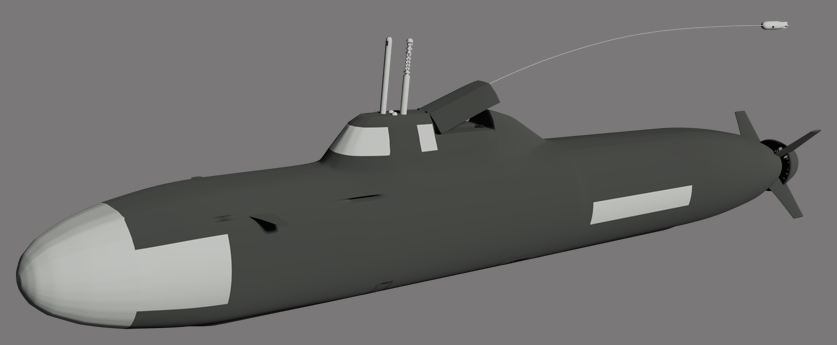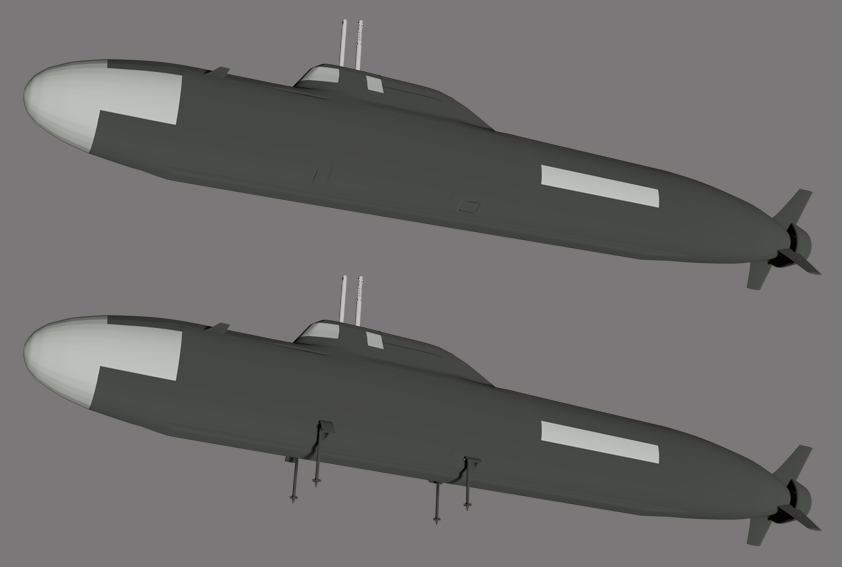Navigating the World of Strikepod

Today we have published the first semi-definitive guide to the ever-expanding world that is Strikepod. We hope this handy glossary will help readers to familiarize themselves with, and stay current on, the myriad elements inhabiting our undersea realm - vessels, sensors, weapons, operations, and more. The glossary will be updated regularly, so in addition to posting the first edition below, you may also find the most current edition via the link on our homepage (http://strikepod.com/glossary).
ABLE
A Strikepod deployed to ICEX 2018, which, together with Strikepod Banner, engaged three Istina-class microsubmarines that breached the exercise perimeter and harassed the USS Connecticut, passing within meters of her hull before escaping.
ADSEWA
The Atom-class Advanced Seabed Warfare (ADSEWA) module houses a suite of improved undersea communications and electronic warfare technologies, as well as highly advanced pressure, magnetic, and acoustic sensors, including the Seabed Static Array System (SEASTAR).
Alpha Pod
The very first active duty Strikepod, Alpha deployed to the Chesapeake Bay in September, 2016, to guard the USS Zumwalt and other U.S. naval vessels as part of Baltimore Fleet Week. Alpha also took part in Operations Robust Probe/Robust Purge, and the Battle of Locust Point.
AMBER
Project AMBER took place during ICEX 2018, to assess the viability of the Strikepod as a full-spectrum Arctic seabed warfare platform versus fixed undersea infrastructure, or the placement of static bottom munitions or CAPTOR-style mines. Atom-class microsubmarines assumed the role of sensors and effectors - sonar arrays, communications nodes, weapons - and were configured as mobile, hovering, or fixed Strikepods, engaging simulated targets both on and below the surface while dynamically reconfiguring to compensate for simulated losses or malfunctions.
AUDEN
The Atlantic Undersea Defense Network is a proposed defensive network charged with defending the east coast of CONUS against conventional and micronaval threats. Though conceived shortly after the Battle of Locust Point, AUDEN acquired a renewed sense of urgency after the existence of a Russian "doomsday UUV" - Status-6, or Poseidon - was confirmed by the Pentagon via the 2018 U.S. Nuclear Posture Review.
Atom-class
The Atom is a United States microsubmarine leveraging state of the art microtechnologies. Atoms operate in Strikepods, distributed networks of microsubmarines programmed to execute missions of varying scale and complexity, such as anti-submarine warfare (ASW), intelligence, surveillance, and reconnaissance (ISR), mine countermeasures (MCM), and time-critical strike (TCS).

Concept Art: Dhimas Afihandarin
BANNER
A Strikepod deployed to ICEX 2018, which, along with Strikepod ABLE, engaged three Istina-class microsubmarines that breached the exercise perimeter and harassed the USS Connecticut, passing within just eight meters of her hull before escaping.
Beta Pod
A four vehicle pod comprised of two Rogues (Rogue-1 and Rogue-2) and two Relays, Beta joined Operation ROBUST PROBE on September 18, 2016. Beta successfully rendezvoused with Alpha Pod, and swapped Rogue-1 for the Alpha Rogue, which was experiencing propulsion problems and returned to base. Rogue-2 and Beta Relays then took up station near the mouth of the Patapsco River, while Alpha continued to patrol south of the Bay Bridge.
Chesapeake Bay Incident
In early 2016, a disabled Russian Istina-class microsubmarine was recovered off the coast of Cape Charles, Maryland, setting in motion a series of events that would culminate in the first undersea combat engagement of the micronaval era, the Battle of Locust Point.
Classic-1, Classic-2, & Classic-3
Codenames for three Russian Istina-class microsubmarines identified and tracked during Operation Robust Probe, and eventually destroyed during Operation Robust Purge.
Echo-1 & Echo-2
On August 2, 2017, while prosecuting Operation Noble Prowl, Strikepods Echo-1 and Echo-2 engaged four hostile DPRK Gwisin-class microsubmarines while enroute to prosecute an unidentified North Korean submarine operating in the Yellow Sea.
Embedded Remora Module (ERM)
Employed by the Atom-class microsubmarine when in Remora mode, the ERM features a high-powered electromagnet for securing to metallic hulls and other surfaces, as well as a Turbo-Injected Quadhook (TIQ) assembly for securing to rubberized (i.e. anechoic) surfaces.

Concept Art: Dhimas Afihandarin
Eminent Shadow
A large-scale microsubmarine deployment to the South China Sea, where Strikepods are currently monitoring the waters near Fiery Cross, Subi, and Mischief Reefs for PLAN surface and undersea operations.
FFG(X)-M
A proposed first generation unmanned microfrigate, FFG(X)-m is a micronaval variant of FFG(X), designed and constructed in parallel with FFG(X), thereby enabling technical and material synergies. With a mission to defeat threats in the microbattlespace, FFG(X)-m utilizes nanomissiles, self-guided nanoprojectiles, and directed energy weapons to defeat enemy drone aircraft as they become ever smaller and more maneuverable. Microfrigates could be produced in larger numbers than the proposed procurement profile for FFG(X) (one unit in 2020 and 2021, with two in each of the following nine years), and at a markedly reduced cost. A network of unmanned microfrigates would reduce the demand on high end combatants, minimize the risk to human life, and extend the tactical grid well beyond the horizon.

Gamma Pod
A five ship Strikepod comprised of one Rogue, two Relays, and two Remoras, Gamma joined Operation ROBUST PROBE on September 23, 2016, to patrol an area near Smith Island in the Chesapeake Bay.
Gwisin-class
The Gwisin is a North Korean microsubmarine based largely on the Russian Kilo-class. The stern section, however, is nearly identical to that of the Shāyú-class, suggesting that the DPRK has benefitted from technical assistance from the Chinese. In August, 2017, Strikepods Echo-1 and Echo-2 engaged four Gwisins while prosecuting a manned DPRK submarine in the Yellow Sea.

Concept Art: Dhimas Afihandarin
INDIGO CLOAK
A Strikepod deployment currently underway in the Persian Gulf with a mission to patrol for IRCGN Qom-class microsubmarines. Operation INDIGO CLOAK began in October, 2017, with Strikepods engaging in mine countermeasures (MCM), intelligence, surveillance and reconnaissance (ISR), and anti-submarine warfare (ASW). On April 14, 2018, Strikepods defending the destroyer USS Higgins (DDG-76) engaged a swarm of twenty four Iranian Qom-class microsubmarines in the hours leading up to strikes against Syrian chemical weapons installations.
Istina-class
The Istina is a Russia microsubmarine based on the Oscar II SSGN. It is equipped with a wide range of advanced undersea communications technologies and sensors, including flank, bow, and topside sonar arrays, front and rear facing high definition video, and a micro-SOCKS system for wake detection. In September and October of 2016, a disabled Istina-class microsubmarine was recovered off the coast of Cape Charles, Maryland, setting in motion Operation ROBUST PROBE/ROBUST PURGE during which three additional Istinas were found to be lurking in the Bay, and were eventually destroyed during the Battle of Locust Point. Istinas have also been detected near several east coast naval installations, and are suspected to be responsible for the August, 2017, "scuba diver" sighting inside a secure area at Naval Station Norfolk.

Concept Art: Dhimas Afihandarin
Locust Point
The first combat engagement of the autonomous undersea era, the Battle of Locust Point took place in the Chesapeake Bay on October 14, 2016, just below the surface of Baltimore Harbor during Fleet Week. Three Strikepods of U.S. Atom-class microsubmarines engaged and destroyed three Russian Istina-class microsubmarines after they infiltrated the Bay, and attempted to breach a secure area where the U.S. Navy's stealth destroyer, USS Zumwalt, as well as USS Jason Dunham and USS Leyte Gulf were docked.
Noble Prowl
A series of Strikepod patrols closely monitoring the waters surrounding the Korean peninsula, with a particular focus on Sinpo and Mayang-Do. Patrols are aggressively tracking DPRK submarines in both the Sea of Japan and Yellow Sea, and are on high alert for indications of SSB activity. It was while prosecuting Operation Noble Prowl that two Strikepods engaged four North Korean Gwisin-class microsubmarines while enroute to track a DPRK submarine in the Yellow Sea.
Pasban-class
Pakistan's foray into micronaval warfare, the Pasban has benefitted substantially from reverse engineering of commercial off-the-shelf products, as well as technical assistance from the Chinese. The hull form bears a striking resemblance to that of the Teledyne Gavia, while the stern appears similar in design to that of the Kongsberg's Remus 600, or China's Shāyú-class microsubmarine. The Pasban is highly modular, offering plug and play capability that enables a high degree of flexibility and quick mission turnaround. Reports indicate that the platform includes a "missile module" providing six vertical launch tubes which are used to deploy microbuoys like the Shāyú, but may also be capable of launching nanomunitions like the Indian Saaya.

Concept Art: Dhimas Afihandarin
Qom-class
Evidence indicating Iraninan interest in acquiring a micronaval capability surfaced in September, 2016, when a source within the IRCGN (Islamic Revolutionary Guard Corps Navy) revealed the existence of a program to develop an indigenous microsubmarine. An initial batch of approximately six vessels was deployed to the Persian Gulf to augment Ghadir-class operations, possibly as decoys, as an extension of ISR and ASW capabilities, or possibly armed for asymmetric attacks. It is unknown whether or to what extent Qoms are capable of operating in conjunction with manned platforms, or in coordinated attacks (i.e. swarming), as is the preferred tactic of the Iranian surface fleet. At 1.14 meters, however, it is likely to be used primarily in asymmetric attacks against smaller vessels, such as patrol boats, zodiacs, riverine command boats, or unmanned vehicles (surface and undersea), as well as vulnerable infrastructure.

Concept Art: Dhimas Afihandarin
Relay
A mission mode of the Atom-class microsubmarine, Relays enable communication between shore, space, surface, and undersea assets via a high performance undersea micromodem, and a Coiled Multifunctional Antenna Buoy (CMAB) for VHF/UHF/IIFF/SATCOM access.
Remora
A mission mode of the Atom-class submarine, Remoras provide target prosecution and time critical strike using the Atom's Embedded Remora Module (ERM) which provides a high-powered electromagnet for securing to metallic hulls and other surfaces, as well as a Turbo-Injected Quadhook (TIQ) assembly for securing to rubberized (i.e. anechoic) surfaces. Remoras are also a Strikepod's "first to fight" in the event of a microsubmarine combat engagement.
Robust Probe
A continuation of ISR operations in the Chesapeake Bay in the wake of the Battle of Locust Point, Robust Probe guards against further incursions by Istina-class or other adversary microsubmarines. The operation was expanded in February, 2017, to include the middle Potomac River (in the wake of Istinas being tracked as far north as Hains Point), and would eventually grow to encompass the entire Chesapeake Bay, as well as the James and Elizabeth Rivers near Norfolk, VA.
Robust Purge
The follow-on to Operation Robust Probe, Robust Purge authorized the disruption and/or destruction of the Istina threat in the Chesapeake Bay, and would be the operational precursor to the Battle of Locust Point.
Rogue
A mission mode of the Atom-class microsubmarine, Rogues provide Strikepods with effective command and control utilizing the Atom's range of sophisticated sensory and communication technologies, as well as onboard signal processing, integrated data management, and machine learning provided by an NVIDIA Jetson Tx-2 embedded AI supercomputer.
Saaya-class
India's debut microsubmarine, the Saaya-class, has benefitted heavily from years of indigenous AUV research and development which resulted in such successes as the Maya and AUV-150. Intelligence indicates that the Saaya is based on the Arihant-class ballistic missile submarine, and features an advanced sensor suite providing video and still imagery, satellite communications, magnetic anomaly detection, as well as a specialized "sniffer" spectroscopic capability to detect the presence of diesel emissions, presumably from Pakistani SSKs. In addition to a micro-USHUS integrated sonar, the Saaya also features side-mounted arrays similar to India's Kalvari-class (French Scorpène-class) submarine, as well as four integrated vertical launch tubes just aft of the sail capable of launching microbuoys or possibly nanomunitions.

Concept Art: Dhimas Afihandarin
SEASTAR
Incorporated into the Atom-class ADWESA module, the Seabed Static Array System (SEASTAR) is a passive microsonar array that deploys from a seabed-based Atom-class via a hatch located aft of the sail, and extends upward through the water column to a height of up to fifty meters. A towed version of SEASTAR is currently under development, which would greatly enhance the Atom's hull-mounted microsonar and enable a Strikepod to effectively act as a roving, large-scale sonar array and/or integrated minefield, providing wide operating coverage during A2/AD operations.
Shāyú-class
The PLAN's chief micronaval asset, the Shāyú, is modeled on China's proposed fourth generation SSBN, the Type-098. MASINT has confirmed that the Shāyú's propulsion is micronuclear in nature, enabling missions of potentially unlimited range and endurance. The microreactor powers a pumpjet propulsor, while the hull design features a "Tri" shaped stern, as well as a blended sail and diving planes, providing the Shāyú with impressive acceleration and maneuverability. "Missile" hatches along the top of the hull are used to deploy microbuoys during ASW operations, and to provide communications when surfacing is not possible, due to sea state or other impediment. Strikepods have engaged Shāyús in the South China Sea during Operation Eminent Shadow.

Concept Art: Dhimas Afihandarin
Status-6/KANYON/Poseidon
Also known as KANYON, or Poseidon, Status-6 is a Russian "intercontinental nuclear-armed undersea autonomous torpedo" designed not only to destroy coastal targets, such as ports and naval bases, but render those areas uninhabitable for nearly a century. Although the existence of Status-6 has been acknowledged by the Pentagon's 2018 Nuclear Posture Review, its purported capabilities - 100 MT warhead, cobalt-60 "salting," running depth of 1000 meters, range of 10,000 kilometers, speeds as high as 56 (or even 100) knots - have yet to be confirmed. The vehicle is scheduled to be deployed by 2027.
